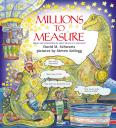Millions to Measure, written by David M. Schwartz and illustrated by Steven Kellogg, is an interactive picture book that is sure to keep the attention of school-aged children as they go on a journey toward understanding measurment.
Summary: In this book, Marvelosissimo the Mathematical Magician takes four children on a journey to see how people measured many years ago and how measurement has evolved over time. The ways that people measured distance, size, weight, and volume were inefficient because there was not a constant source of measurement that could be applied to all people and things around the world. Eventually, standards of measurement were created so that everything could be measured using the same source of measurement. Marvelosissimo the Mathematical Magician introduces the way that people measure length, distance, weight and volume, as well as the differences between the metric system and standard English system.
“Many people believe that the United States will eventually join the rest of the world and measure only in the metric system. But you don’t have to wait until then, because you already know how!”
The usage and understanding of the metric system is promoted in this book, which is beneficial as the entire world becomes more scientifically and mathematically driven.
Curriculum Connections: This would be a great book for grade two studying SOL 2.1: Scientific Investigation, Reasoning, and Logic. Within this SOL students should understand the usage and terminology of both the metric and standard systems of measurement. This book could be used as an introduction to a lesson involving the observation and investigation of various items using the two systems of measurement. This will allow practice with the terminology and sources of measurement that will be used throughout the year during scientific activities and experiments.
Additional Resources:
-
Create a Measuring Lab where you create separate areas for students to measure items for Distance, Weight, and Volume. Students can work in teams of two: one can measure and the other can record the measurement.
-
This worksheet asks students to record the temperature shown in the drawing of a given thermometer. They then are to draw a red line at a temperature of their choice and draw something that they would do at this temperature.
-
Interactive bulletin board idea: students are to find items that are one inch in length to be displayed on a bulletin board; the board will also display a question of the day and prize can be given to those students who answer correctly. There is also a corresponding worksheet for students to measure seven of their favorite items in their rooms.
-
This worksheet is based on the book Millions to Measure and allows students to use their own innovative source of measurement to measure various items. They are then asked how they would measure other various items using the units of measurement.
General Information:
Book: Millions to Measure
Author: David M. Schwartz
Illustrator: Steven Kellogg
Publisher: HarperCollins
Publication Date: 2003
Pages: 40
Grade Range: K-3 (ages 4-8)
ISBN: 0688129161

